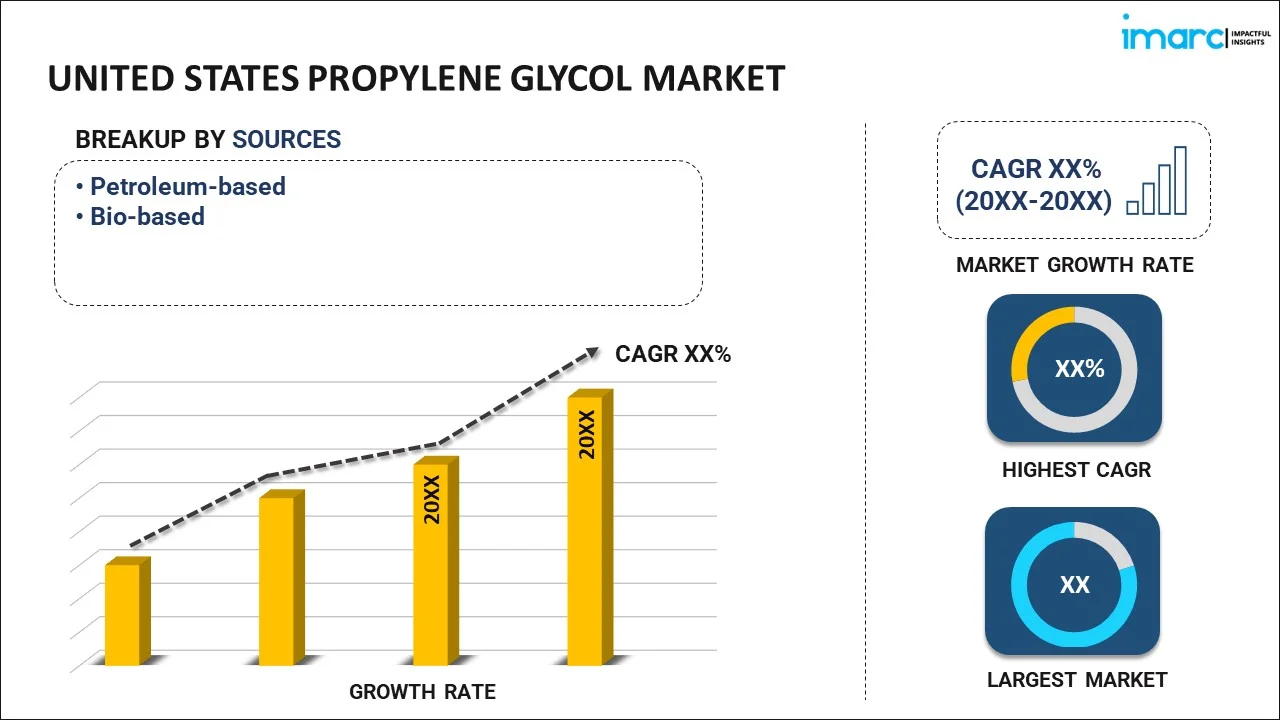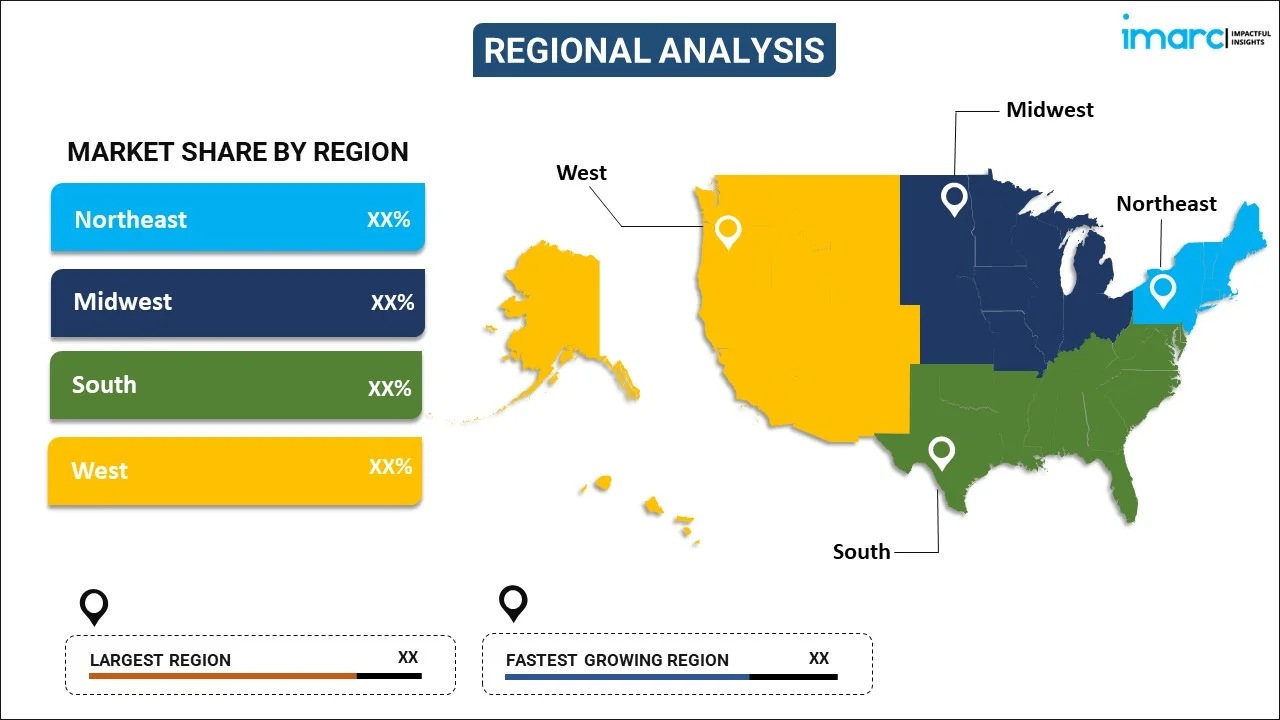
United States Propylene Glycol Market Report by Source (Petroleum-based, Bio-based), Application (Unsaturated Polyester Resins, Antifreeze and Functional Fluids, Food, Drug, and Cosmetics, Liquid Detergent, Paints and Coatings, and Others), End Use Industry (Transportation, Building and Construction, Food and Beverage, Pharmaceuticals, Cosmetics and Personal Care, and Others), and Region 2025-2033
Market Overview:
The United States propylene glycol market size is projected to exhibit a growth rate (CAGR) of 5.20% during 2025-2033. The rising product demand in the food and beverage industry, the expanding applications in the pharmaceutical industry, the growing product usage in the formulation of cosmetic and personal care products, and the expansion in antifreeze and deicing applications are some of the factors propelling the market.
|
Report Attribute
|
Key Statistics
|
|---|---|
|
Base Year
|
2024 |
|
Forecast Years
|
2025-2033 |
|
Historical Years
|
2019-2024
|
| Market Growth Rate (2025-2033) | 5.20% |
Propylene Glycol (PG) is a colorless, odorless, and tasteless organic compound with the chemical formula C3H8O2. It is a synthetic liquid alcohol that belongs to the class of diols or glycols, characterized by its two hydroxyl (OH) groups. A versatile and water-soluble substance, propylene glycol finds widespread applications across various industries. One of its primary uses is as a humectant in the food and beverage industry, where it helps retain moisture in products like baked goods, confections, and certain dairy items. In the pharmaceutical sector, propylene glycol serves as a solvent and carrier for active ingredients in various drug formulations. Its presence in cosmetics and personal care products is notable, contributing to the texture, stability, and moisturizing properties of items such as skincare products, hair care formulations, and toiletries. Beyond these consumer-oriented applications, propylene glycol is also employed as an antifreeze and deicing agent, particularly in the automotive and aviation industries, owing to its ability to lower the freezing point of water.
United States Propylene Glycol Market Trends:
The market in the United States is majorly driven by the increasing demand in the food and beverage sector. As a humectant and stabilizer, propylene glycol plays a crucial role in maintaining the moisture content and texture of various food products, including baked goods, confections, and processed foods. The expanding processed food industry, coupled with consumers' preference for longer shelf life and quality maintenance, significantly contributes to the growth of the market. The pharmaceutical industry is another major contributor to the market's growth. Propylene glycol's solubilizing properties make it an essential component in drug formulations, enhancing the bioavailability and stability of pharmaceutical products. With continual advancements in the pharmaceutical sector and the development of novel drug formulations, the demand for propylene glycol is expected to persist and grow. Besides, cosmetics and personal care products also drive the propylene glycol market. The compound's ability to act as a moisturizer and improve the consistency of cosmetic formulations, including creams, lotions, and hair care products, makes it a sought-after ingredient. The rising consumer inclination towards skincare and grooming, along with the growth of the beauty and personal care industry, further propels the demand for propylene glycol. Propylene glycol's role as an antifreeze and deicing agent in the automotive and aviation industries contributes significantly to its market growth. The compound's capacity to lower the freezing point of water makes it an effective choice in various weather conditions, ensuring the reliability and safety of vehicles and aircraft. Furthermore, the industrial sector widely employs propylene glycol in diverse applications, such as heat transfer fluids, hydraulic fluids, and coolants. Its non-toxic nature and compatibility with various materials make it a preferred choice in industrial processes. As industries focus on adopting environmentally friendly and sustainable practices, the versatility of propylene glycol positions it as a key component in meeting these objectives, strengthening the market.
United States Propylene Glycol Market Segmentation:
IMARC Group provides an analysis of the key trends in each segment of the market, along with forecasts at the country level for 2025-2033. Our report has categorized the market based on source, application, and end use industry.
Source Insights:

- Petroleum-based
- Bio-based
The report has provided a detailed breakup and analysis of the market based on the source. This includes petroleum-based and bio-based.
Application Insights:
- Unsaturated Polyester Resins
- Antifreeze and Functional Fluids
- Food, Drug, and Cosmetics
- Liquid Detergent
- Paints and Coatings
- Others
A detailed breakup and analysis of the market based on the application have also been provided in the report. This includes unsaturated polyester resins, antifreeze and functional fluids, food, drug, and cosmetics, liquid detergent, paints and coatings, and others.
End Use Industry Insights:
- Transportation
- Building and Construction
- Food and Beverage
- Pharmaceuticals
- Cosmetics and Personal Care
- Others
The report has provided a detailed breakup and analysis of the market based on the end use industry. This includes transportation, building and construction, food and beverage, pharmaceuticals, cosmetics and personal care, and others.
Regional Insights:

- Northeast
- Midwest
- South
- West
The report has also provided a comprehensive analysis of all the major regional markets, which include Northeast, Midwest, South, and West.
Competitive Landscape:
The market research report has also provided a comprehensive analysis of the competitive landscape in the market. Competitive analysis such as market structure, key player positioning, top winning strategies, competitive dashboard, and company evaluation quadrant has been covered in the report. Also, detailed profiles of all major companies have been provided.
United States Propylene Glycol Market Report Coverage:
| Report Features | Details |
|---|---|
| Base Year of the Analysis | 2024 |
| Historical Period | 2019-2024 |
| Forecast Period | 2025-2033 |
| Units | US$ Million |
| Scope of the Report | Exploration of Historical Trends and Market Outlook, Industry Catalysts and Challenges, Segment-Wise Historical and Future Market Assessment:
|
| Sources Covered | Petroleum-based, Bio-based |
| Applications Covered | Unsaturated Polyester Resins, Antifreeze and Functional Fluids, Food, Drug, and Cosmetics, Liquid Detergent, Paints and Coatings, Others |
| End Use Industries Covered | Transportation, Building and Construction, Food and Beverage, Pharmaceuticals, Cosmetics and Personal Care, Others |
| Regions Covered | Northeast, Midwest, South, West |
| Customization Scope | 10% Free Customization |
| Report Price and Purchase Option | Single User License: US$ 3699 Five User License: US$ 4699 Corporate License: US$ 5699 |
| Post-Sale Analyst Support | 10-12 Weeks |
| Delivery Format | PDF and Excel through Email (We can also provide the editable version of the report in PPT/Word format on special request) |
Key Questions Answered in This Report:
- How has the United States propylene glycol market performed so far and how will it perform in the coming years?
- What has been the impact of COVID-19 on the United States propylene glycol market?
- What is the breakup of the United States propylene glycol market on the basis of source?
- What is the breakup of the United States propylene glycol market on the basis of application?
- What is the breakup of the United States propylene glycol market on the basis of end use industry?
- What are the various stages in the value chain of the United States propylene glycol market?
- What are the key driving factors and challenges in the United States propylene glycol?
- What is the structure of the United States propylene glycol market and who are the key players?
- What is the degree of competition in the United States propylene glycol market?
Key Benefits for Stakeholders:
- IMARC’s industry report offers a comprehensive quantitative analysis of various market segments, historical and current market trends, market forecasts, and dynamics of the United States propylene glycol market from 2019-2033.
- The research report provides the latest information on the market drivers, challenges, and opportunities in the United States propylene glycol market.
- Porter's five forces analysis assist stakeholders in assessing the impact of new entrants, competitive rivalry, supplier power, buyer power, and the threat of substitution. It helps stakeholders to analyze the level of competition within the United States propylene glycol industry and its attractiveness.
- Competitive landscape allows stakeholders to understand their competitive environment and provides an insight into the current positions of key players in the market.
Need more help?
- Speak to our experienced analysts for insights on the current market scenarios.
- Include additional segments and countries to customize the report as per your requirement.
- Gain an unparalleled competitive advantage in your domain by understanding how to utilize the report and positively impacting your operations and revenue.
- For further assistance, please connect with our analysts.
 Inquire Before Buying
Inquire Before Buying
 Speak to an Analyst
Speak to an Analyst
 Request Brochure
Request Brochure
 Request Customization
Request Customization




.webp)




.webp)












